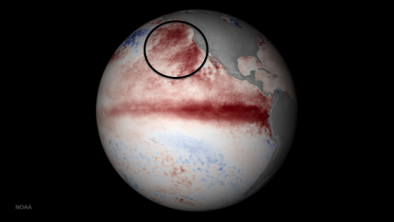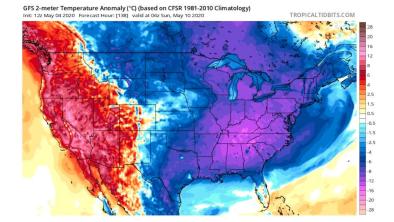
Large Scale Global Circulation Change
Changes that occur in one part or region of the climate system can affect others.[1] One of the key ways this is happening is through changes in atmospheric circulation patterns as the planet retains more heat. Global warming affects regional temperature and humidity structures, and winds respond by changing the intensity and structure of the circulation.
Read More





Climate science at a glance
- Many weather systems continuously weave around the globe. When averaged over many years, a global pattern of air movement emerges, and global warming affects these patterns.
- In recent decades, global atmospheric circulation structure and associated winds have been displaced toward the poles. Observed trends include the poleward expansion of the Hadley cell, the poleward shift and increase in mid-latitude westerly winds and contraction of the northern polar vortex.
- The response of the atmospheric large-scale circulation to rising greenhouse gas emissions is complex and an ongoing area of research.
- Studies have linked record warm temperatures in the Arctic to changes in atmospheric circulation patterns in the mid-latitudes.
- The IPCC fifth assessment report states, “it is likely that circulation features have moved poleward since the 1970s, involving a widening of the tropical belt, [and] a poleward shift of storm tracks and jet streams.”[1]
Background information
What is large scale global circulation?
At a fundamental level, large scale circulation patterns result from asymmetries at the Earth's surface – mountains, continent–ocean contrasts, and sea surface temperature asymmetries - as well as the temperature contrast between the equator, which is closest to the sun, and the poles, which receive less of the sun's energy. Large-scale circulation patterns help to distribute heat and moisture across the planet. When averaged over many years, a global pattern of air movement emerges, and a growing body of evidence is showing that climate change affects these patterns.
Definitions
- The Hadley cell, Ferrel cell and Polar cell are three large scale wind circulations that occur in the northern and southern hemispheres. In the Hadley cell, air blows toward the equator, where it warms and rises, precipitates, and heads toward the poles in the upper atmosphere, ultimately descending between 30° and 40° degrees north and south, bringing warm and dry air. In the middle Ferrel cells, air flows poleward and eastward near the surface and equatorward and westward at higher levels. The smallest and weakest cells are the Polar cells, which extend from between 60° and 70° north and south, to the poles. Air in these cells sinks over the highest latitudes and flows out towards the lower latitudes at the surface.
- Planetary waves (also known as longwaves or Rossby waves) form primarily as a result of the Earth's geography and help transfer heat from the tropics toward the poles and cold air toward the tropics in an attempt to return the atmosphere to balance. They also help locate shortwaves, as indicated by the jet stream, and mark out the track of surface weather systems. They can be stationary or travel in longitude with periods of a few days to a few weeks.
Stationary planetary waves are planetary waves that are relatively stable in terms of their location on seasonal timescales. For example, stationary waves contribute to the relative dryness and coldness of Northern Hemisphere continents in midwinter, the relative dryness of the Middle East, Mediterranean, and North Africa in summer, and the seasonal migration of precipitation in East Asia. The slow motion of these waves often results in fairly long, persistent weather patterns, blocking, and storm track variability.
Propagating planetary waves are planetary waves that propagate (or move) in an eastward or poleward direction. They can be identified by large-scale variations in the pressure, temperature, winds, and composition.
Dynamic processes drive large-scale atmospheric circulation, including wind and pressure systems that determine where it is dry, wet, hot, etc. Dynamic processes are in contrast to thermodynamic processes, which include energy exchanges and phase changes related to land‐atmosphere interactions and convective processes.
Differences between the Northern and Southern Hemispheres
Compared to the Northern Hemisphere, the Southern Hemisphere has a lot more open ocean. Notably, there is a band of water North of Antarctica and below Australia, Africa and South America that is completely uninterrupted by land masses. This open band allows for a strong circumpolar ocean current around Antarctica that is unique to the Southern Hemisphere. The strong circumpolar current creates atmospheric circulation patterns throughout the Southern Hemisphere that are more “zonally symmetric”—a meteorological term that means more consistent across latitudes.
Large scale global circulation change trends
- (Francis and Vavrus, 2012, 2015; Liu et al., 2012; Tang et al., 2014): Arctic warming is linked to the increasing amplitude of stationary waves.[2][3]
- (Cohen, Pfeiffer, and Francis 2018; Delworth et al. 2016; Francis and Skific 2015): Rapid warming in the Arctic (known as Arctic amplification) is linked to more extreme winter weather in the mid-latitudes.[4][5][6]
- (Kornhuber and Tamarin-Brodsky, 2021; Kornhuber et al. 2018; Vavrus et al. 2017): Rapid Arctic warming is linked to more extreme summer weather in the mid-latitudes.[7][8][9]
- (Peterson et al. 2013; Wang et al 2012): There has been a northward shift in winter storm tracks since detailed observations began in the 1950s and an associated poleward shift of the subtropical dry zones.[10][11]
- (Reichler, 2009): Depending on the indicator under investigation, scientists have observed tropical widening by 0.3 to 3.1° latitude per decade since 1979, with a consensus widening of about 1.4°.[12] (Note: Part of the wide range is because the boundary between the tropics and extratropics is not well-defined and depends on the definition of specific indicators of tropics width—such as the position of the jet stream, where surface winds change from westerly to easterly or physical indicators like ozone concentration and humidity.)
Studies attribute large scale global circulation change to global warming
- (Mann et al. 2017): Global warming is linked to the increasing amplitude of stationary waves. There is a clear human fingerprint behind the increase in temperature distributions favoring planetary wave stalling.[13]
- (Francis and Skific 2015): The disproportionate warming in the Arctic warming and resulting weakening of the poleward temperature gradient is causing the Northern Hemisphere circulation to assume a more meridional character (i.e. wavier).[4]








